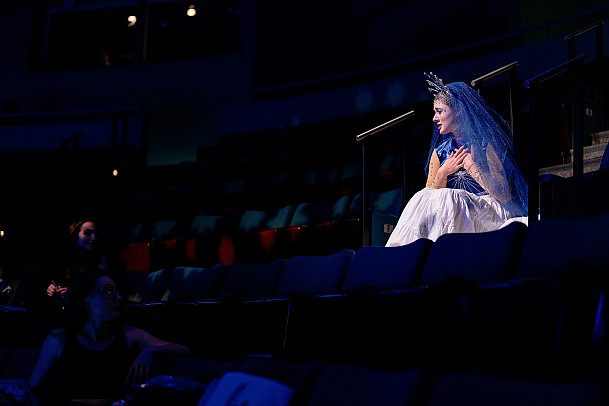Public Engagement
Revealing What It Is To Be Human: The Power of Theatre and Storytelling
The arts have been and continue to be an incredible vehicle in which people come into a shared space, carrying with them their differing lives and perspectives, and yet still experience this connection in their ability to feel collectively, to know what it is to be human. I had the privilege of speaking to Southwestern’s very own Assistant Professor of Theatre, Gabriel Peña, about his relationship to storytelling, his recent project directing of the Sarofim School of Fine Arts’ fall production of Luna, and the continued importance of the arts in sustaining a healthy society.
March 31, 2025
March 31, 2025
The arts have been and continue to be an incredible vehicle in which people come into a shared space, carrying with them their differing lives and perspectives, and yet still experience this connection in their ability to feel collectively, to know what it is to be human. Nineteenth-century poet and playwright, Oscar Wilde, spoke to this sentiment in the Theatre, “I regard the Theatre as the greatest of all art forms, the most immediate way in which a human being can share with another the sense of what it is to be a human being” (Rosky).

I had the privilege of speaking to Southwestern’s very own Assistant Professor of Theatre, Gabriel Peña, about his relationship to storytelling, his recent project directing of the Sarofim School of Fine Arts’ fall production of Luna, and the continued importance of the arts in sustaining a healthy society.
Thank you so much for taking the time to talk to me about your work! Before we get started, really diving into your work and your thoughts on the lasting impact of the arts, could you briefly introduce yourself, explain how long you’ve been at Southwestern, and describe some of the things that are important to you?
Professor Gabriel Peña (GP): “I’m Gabriel Peña, or Gab, and I’ve been at Southwestern for almost 3 years. I’m an Assistant Professor of Theatre, and my specialty and area of focus is performance, specifically acting. Some of the things that I find particularly important in my personal, professional, and artistic life are the pursuit of authenticity, the promotion of diverse forms of expression, and thoughtful, humane, and empathetic conversations. Also, I believe it’s vital to ferociously support the arts in order to sustain a healthy society.”
How did you get involved in and develop a love for theatre?
GP: “My gateway to Theatre was really my sister and the middle school morning announcements. After I stopped playing soccer, my folks needed me to partake in some kind of activity, and so I copied my sister and did a Theatre camp. That experience, coupled with the realization that memorizing the text for my middle school morning announcements and having a point of view about what I was saying could garner positive reactions, sparked my earliest interest in performance. From there, I got pulled into high school plays by a teacher who saw potential in me, then it was university productions at Pomona College, and after undergrad, I took a few years to explore if performance was what I wanted to dedicate my life to. That exploration took me to Austin for several years, and my work expanded from the stage into camera, voiceover, and new media work. I, then, pivoted my honed passion into an MFA program at Penn State University and spent a few years in New York City accruing more professional experience before coming to Southwestern.
I’d say that my love of Theater was also fueled by an exploration of self, trying to define my beliefs, my style, my voice, and it was also inspired by a realization that I could expand and elaborate on my humanity through performance, which I still find to be incredibly powerful.”
Effective art contains some sense of authenticity and vulnerability from its creator or performer and that primes the potential for thoughtful, humane, and empathetic conversations between artwork, artist, and audience.
How do you continue to foster the same passion for theatre and storytelling that you had when you first encountered it? Does it still look the same as it once did? How does it translate to your career as an educator now?
GP: “In some ways, I don’t foster the ‘same’ passion for Theatre, but rather, I hold onto a curiosity that remains relentless while my passion for Theatre evolves. As an example, when I first encountered theater, I found it very seductive because it allowed me to share parts of my humanity that were not always safe or acceptable to demonstrate or experience in public. On a stage, however, not only was I allowed to explore those places (like sadness, anger, silliness) but I was rewarded with applause for doing so.
As I got older, one of the things that added to the excitement of theater was that it was a space where complex ideas could be explored in a way that could shape the world outside of the Theatre. In my undergraduate years, I studied abroad in Argentina, and I found myself fascinated with the ways that courageous theatre artists like Griselda Gambaro or Osvaldo Dragún were able to throw stones at a repressive and authoritarian regime with their plays. Whether it’s impacting one’s inner world or the world at large, theatre is really an endless source of beauty and possibility. Recognition of the power of theater as a natural vehicle for so many different avenues of academic and artistic exploration certainly informs my teaching and research. My introductory performance course explores acting as a way to build self-knowledge, while my advanced acting classes focus on how to unearth who a character is, how to approach their experience, and how to justify their actions and craft that knowledge and instinct into a performance. These close reading and behavioral analysis skills are tools one might expect to encounter in a law class or rhetoric course rather than a theater, but these are the instruments we utilize in our pursuit of corporealizing ideas and living the various experiences of humanity.”
The Theatre enables the actor to explore both familiar and distinct experiences and consider perspectives different from their own. Understanding that character analysis requires that the actor approach the role with humility and empathy, a willingness to regard them as human as anyone else. The same can be said of our interactions in our everyday lives. There is no singular or definitive or universal human experience. Each of us is shaped differently by our identities and circumstances.
GP: “Alternatively, in my lecture course, Latinx Drama, students encounter how theater, political science, culture, and history all collectively inform the analysis of dramatic texts. The various avenues that are traveled in Latinx Drama are reflective, in their own way, of that deep potential and possibility that theatre holds.”
This fall, you directed a production of Ramón Esquivel’s Luna from November 18th until the 24th. The story follows Soledad, a young girl who is the daughter of migrant farm workers. As she constantly changes homes to accommodate her parents’ work, she finds herself struggling to make friends as the “new girl” at each school. Instead, she finds a friend in the company of the moon, Luna. What was it like telling this story? Why at this time did it feel like a necessary story to tell during this season?
GP: Directing Luna was truly a dream. I’m Latino, and I spent years and years in formal and informal performance training where none of the roles I played were specifically written by or for Latinos so the chance to get to bring this work to the stage, a play by a Latine author and centering around a Latino family, was a privilege. I found that directing a piece specifically for a young audience—elementary school in this case—was more fun than I possibly could have imagined. We had an audience that was completely prepared to go on an imaginary adventure with us, and that kind of incredible imaginary capacity is not always something that adults have. It’s a skill that children can access organically and that sometimes adults have to become reacquainted with or reignite as we get older.
As for the relevance and importance of Luna, it became clearer and clearer that in our current political climate and global times it is vital to forefront stories of migrants and be clear about the dignity, beauty, and virtue of immigrants, the working class, Latinos and other identities that are oftentimes mis- or under-represented in popular culture. It is also essential that we bring humanity into the stories of folks whose labors often go unappreciated or unseen.”
So often, the stories of people of color, migrants, the working class, and others are sidelined or entirely invisibilized in the interest of the continued prioritization of canonical or culturally dominant voices. Staging a play that very explicitly values the multitude of ways that Latinx and migrant communities resist harmful, dominant rhetoric to instead affirm their own dignity, beauty, and virtue, especially at an institution that is predominantly white, and yet recently recognized as a Hispanic Serving Institution, is a powerful and meaningful act.

It’s my understanding that for Luna’s performances, your production and ensemble cast hosted audiences of young students to see the production! What was this experience like for you as a director and for your ensemble? How did your young audience members seem to respond to and connect with the material? What takeaways did you hope they would leave the show with?
GP: “The best part of working on Luna was seeing how our audiences reacted to the material. The children responded so deeply to the play and could connect, regardless of their individual backgrounds or specific ages, to the story of a young girl who found it hard to make friends. They, like our protagonist Soledad, also fell in love with Luna - a symbolic character that the students immediately recognized and accepted as a benevolent force in the universe. They understood how difficult it was to be in a situation where you love your family but find the circumstances of your family difficult. I hope that the students left with an appreciation for any of their fellow students and friends who identify as immigrants or migrants. I hope that it left them with a curiosity for who is behind things that perhaps we take for granted, like the food that ends up on our table. I hope that they left with a sense that the world can sometimes be difficult, that we sometimes have to live with that difficulty, but that this doesn’t mean that there isn’t still some kind of magic in our existence and in the universe.”
There is some kind of magic in our existence and our ability to connect. One of the most vulnerable and powerful ways this translates is into the art we create.
As an artist yourself, how do you see art as being invaluable to connecting to people, social change, and more?
GP: “Art is absolutely invaluable as a medium for connection because it is the highest expression of our humanity. There are limits to the stories that numbers and empirical data can tell. I believe that the distance between people can be bridged by art more than by any other force in the universe. Be it a poem or song, a painting or sculpture that two people are witnessing together, or a play that is being experienced by an entire community, works of art function as places where we can touch and be touched by the essential qualities that make us human - love, fear, dreams, desires, faults, and resilience. Art shows us the contours of our whole self and its potential to advance and better society. The power of theatre is something that is well known and documented. While some artists argue that art should be a mirror for reflection and others, famously Bertolt Brecht, feel it’s a hammer with which we are to shape society, history holds clear evidence that art shifts culture. This power is one reason FDR developed the Federal Theatre Project, and the fear of its great power is why that same program was attacked by the so-called House Committee of Un-American Activities. Whether FDR or the ancient Greeks, there is a sentiment that without Theatre and greater support for the arts, democratic, open, healthy societies are endangered. When I’m asked what universities can do to support students of
various backgrounds, identities, interests, and so forth, my answer is always the same. Make art, make art, and make art.”
How do you view art as publicly engaged?
GP: “The Arts are potentially the most inherently publicly engaged feature any university offers. In theater, there is always an awareness and sensibility for the fact that our work is meant to be shared with the public. It is not created for peer review, or for specialists in our field - it’s for the citizenry, for the people. I think it’s very special that our work can be enjoyed by folks of various ages, identities, and histories. A first-time theater goer and a theater aficionado might be in the same audience on any given night, and that is beautiful, democratic, and special. We engage with the public because we do not exist without a public.”
How do you attempt to channel this sentiment in your personal work as a teacher-scholar, a director, and an artist?
GP: I think the way that this manifests most clearly is in an insatiable curiosity. I feel a responsibility as a Theatre artist to take an interest in humanity at large. This means that I’m curious about a spectrum of stories, especially those that reflect or capture as much of the public as possible. This sentiment is present and evidenced in the breadth of works that we explore in our courses and put on as productions. You’ll find stories about migrant farm workers navigating childhood and family, mathematicians arguing proofs and balancing personal demons, young people juggling faith practices and profound grief, New Jersey Nuns having fun, and so much more. A central pillar to SU’s identity is that the university emphasizes Paideia, making connections. The Theater is a place where we’re constantly facilitating connections between different disciplines, between abstract ideas and their physical realization, and between our artists and the audience.”
And to close, how would you say Southwestern’s Theatre Department does the same, channeling this sentiment and commitment to public engagement?
GP: “The most obvious, of course, is that we put up seasons with multiple opportunities for our students to share their work, their process, and their skills with the public. The laughter, the gasps, and the applause are part of an ancient back-and-forth, a timeless public engagement that Theatre has always had. Less poetically, but no less importantly, we’ve had students share their skills as educators and as artists with the Georgetown Palace, a beloved institution right here in the heart of downtown. There are the TYAs (Theater for Young Audiences) like Luna, which are shown at special hours of the day to make them accessible to elementary schools. The depth of this engagement reminds me of a fabulous moment that occurred during our run of Luna. A colleague shared with me a “full circle” moment that they witnessed. There was an elementary school teacher who brought her class to see Luna, and she had been a student at Southwestern, where she participated in a TYA as an actor herself. Not only that, when she was a young child, she came to SU to see one of these TYA performances. Amazing, right!? That cycle, or journey, really reflects just how deep the engagement with the public can be via the magic of theater, how its impact can echo in a profound way.”
The lasting impact of encountering and experiencing a story, a work, or an image that speaks to the humanity that lives within each of us is like being called home.
I want to thank Professor Peña again for taking the time to speak to me and talk about the ever-necessary need for diverse stories and voices that allow us to find not only representations of ourselves but also experience the different perspectives of others in the Arts.
Works Cited
Rosky, Nicole. “30 Ovation-Worthy Quotes About the Theatre.” BroadwayWorld.com, 4 June 2022, www.broadwayworld.com/article/30-Ovation-Worthy-Quotes-About-the-Theatre-20201115.














